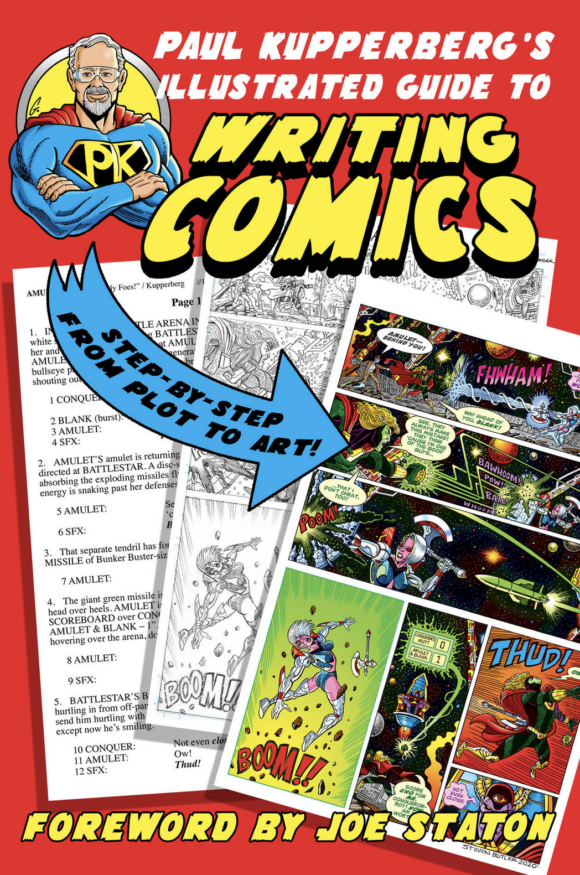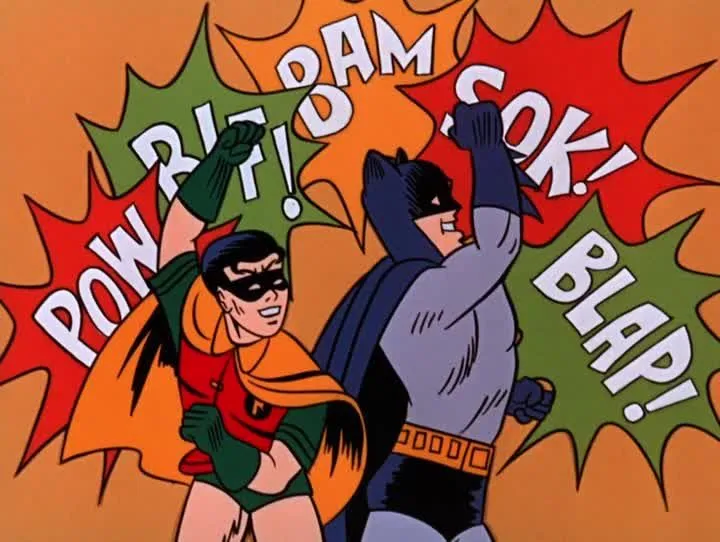A BATMAN ’66 ANNIVERSARY SALUTE: The celebrated Mr. K channels his inner 10-and-a-half-year-old…

Hey, it’s the anniversary of the 1966 Batman show! (56 years if you’re counting.) We’ve got a bunch of groovy stories for you this year, so make sure you check out the links at the bottom of this post. Meanwhile, dig this groovy piece by 13th Dimension columnist Paul Kupperberg.
And while you’re at it, treat yourself to a copy of Zlonk! Zok! Zowie! The Subterranean Blue Grotto Essays on Batman ’66 – Season One, an in-depth episode guide edited by 13th Dimension columnist Jim Beard, with entries by a coterie of contributors, including Paul and yours truly. (Click here for more info and to order.) There’s also the sequel — Biff! Bam! Eee-Yow! The Subterranean Blue Grotto Essays on Batman ’66 – Season Two. (Click here.)
Right on.
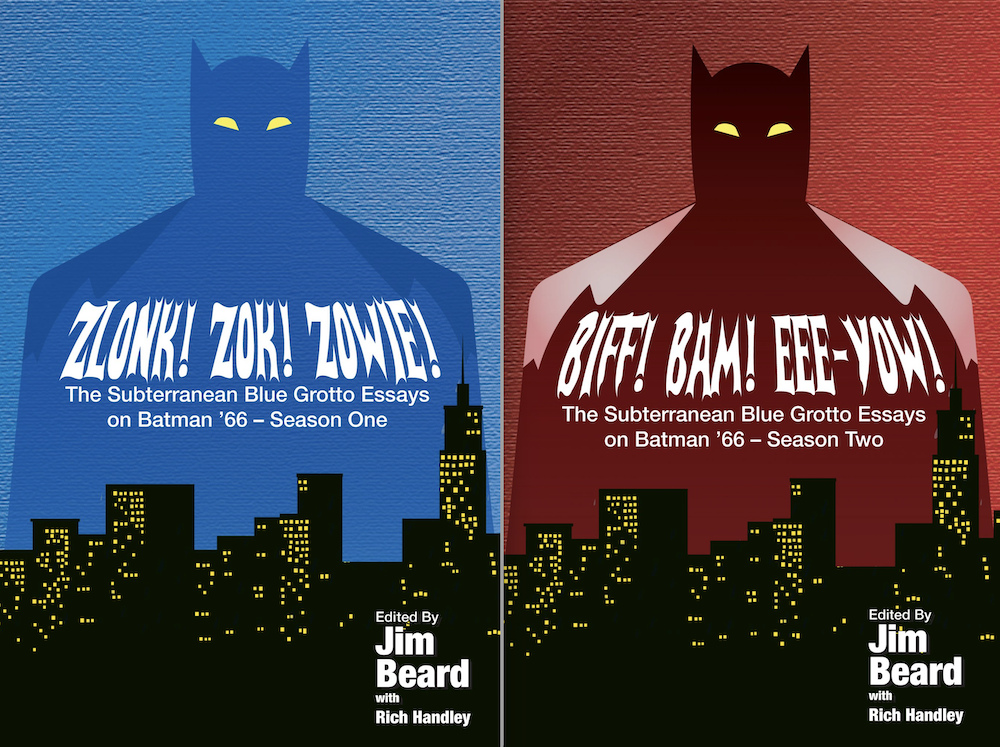
By PAUL KUPPERBERG
(A version of this introduction originally appeared in the August 2017 Connecticut Terrificon Program Book, where Adam West had been the scheduled guest of honor.)
I know where I was at 7:30 p.m. on Wednesday, January 12, 1966. I was planted on the floor in front of our big console television set, tuned to ABC-TV, Channel 7 in New York, eyes glued to the screen for the premiere of Batman, starring Adam West.
I had been reading comic books for what felt like my whole life by then (I was two days shy of being exactly 10 and one-half years old). I devoured the four-color adventures of Batman, Superman, Wonder Woman, and the rest of their super-powered colleagues. And, as much as I loved The Adventures of Superman — it had been a staple of my afterschool TV viewing for years by then — Batman was something new and different.
Batman was bold, bright, and, for its time, totally insane.
Superman battled generic gangsters in suits and ties, a few packing death-rays, maybe the occasional robot or two, but the Man of Steel’s “thrill-packed episodes” looked a little lame next to the supervillain-packed Batman. Even the 1950s color episodes of Superman looked faded and washed out next to the vividly four-colored Caped Crusader.
And Batman had Adam West. And Adam West was the key to making Batman work.
Because in a world inhabited by freaky, crazy foes like the Joker, Catwoman, Egghead, and Lilac the Louie, not to mention a simpering, ineffectual police commissioner and his perpetually angry but otherwise useless second-in-command, as well as a home life that featured a dotty old aunt and a put-upon but game-for-anything butler, the man at the center of it all had to be anything but freaky and crazy. He had to be a rock solid, square-jawed man of honor and integrity.

Batman’s creator was William Dozier, who explained his thinking to a Canadian talk show at the start of the show’s run: “The fairly obvious idea (was) to make it so square and so serious and so cliché-ridden and so overdone and yet do it with a certain elegance and style that it would be funny. That it would be so corny and so bad that it would be funny.”
It was most of those things, but it wasn’t “bad,” despite its creator’s claim. (This was the same man who admitted in another interview that when he had been seen by a friend reading some Batman comic books on an airplane, “I felt a little bit like an idiot.”)
What Dozier did was capture lightning in a bottle, and Adam West and co-star Burt Ward were its conduits. Ward was perfect as the earnest, enthusiastic young protégé, Dick Grayson, aka Robin the Boy Wonder. But the weight of the show rested squarely on the caped shoulders of Batman and his alter ego, Bruce Wayne. If he couldn’t carry the load, the show would collapse under its own campiness.

Adam West understood the role and, unlike Dozier, wasn’t embarrassed to be associated with the Dynamic Duo. In his autobiography, Back to the Batcave, West wrote, “Dozier doesn’t remember at what point he came up with the idea to do the show as a lampoon comedy, but he once said it grew out of his embarrassment from being seen on airplanes with the comic books in his briefcase. I never understood the loathing he had for the (comics) medium. … Maybe he didn’t like people thinking he enjoyed looking at what he considered garbage.”
West’s Batman was sharp and focused, prone to pauses as he put all the clues together in a mind trained from childhood in logic, criminology, and the sciences. He was totally unselfish, and he did not know how to surrender to defeat. His Bruce Wayne, on the other hand, was a flip, young man-about-town with not much on his mind, always rushing off to polo matches or museum openings.
Kids loved Batman and, true to Dozier’s prediction, so did their parents. Adam West never winked or nodded to his viewers like this was some sort of joke he was letting them in on, never played Batman as anything but the most solid, serious, upright citizen of Gotham City. Mom and Dad chuckled along while the young ones watched in rapt, wide-eyed wonder, but the point was that grown-ups were also watching!
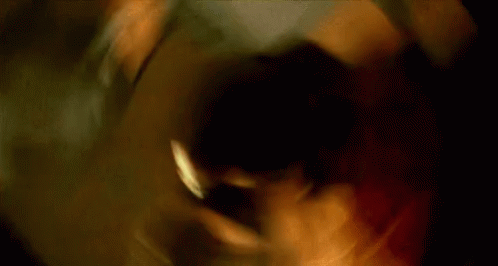
Adam West was already a seasoned veteran with a wide variety of roles under his utility belt by the time he was selected to play Batman. Even then, I knew his face, if not his name, from movies, particularly Robinson Crusoe on Mars (1964) and The Outlaws Is Coming (1965) with the Three Stooges. I’m sure my parents recognized him from any number of earlier roles, co-starring with Paul Newman in The Young Philadelphians, or as Sgt. Steve Nelson on the popular drama The Detectives, or from his guest appearances on numerous popular TV shows, including Perry Mason, The Outer Limits, The Real McCoys, and a lot of Westerns.
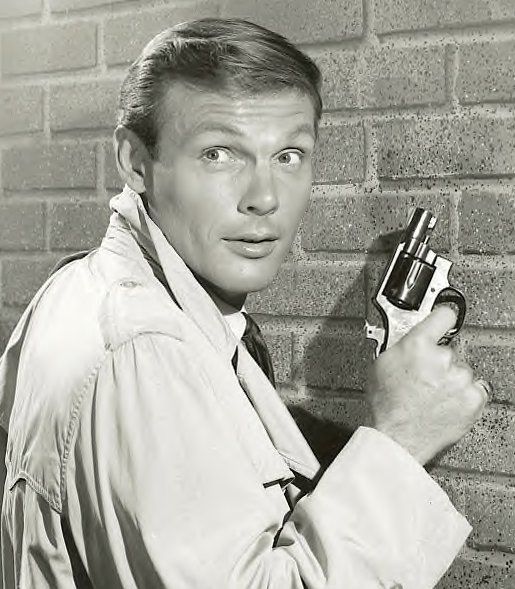
It would be more than 20 years before another actor donned the Bat-suit, and I was excited as the rest of the comics community to see the big budget 1989 Batman hit the big screen. And though I cheered with the rest of the audience when Michael Keaton’s Dark Knight growled to the frightened criminal, “I’m Batman!” the voice of 10 and one-half year old me whispered somewhere in the back of my head, “Maybe… but you’re no Adam West!”
And if you remember where you were on January 12, 1966, at 7:30 p.m. you’ll know exactly what I mean.
Here then, My 13 Favorite BATMAN ’66 EPISODES AS A FIRST-RUN VIEWER, in chronological order:
—
“Hi Diddle Riddle/Smack in the Middle” (Jan. 12-13, 1966). I was 10 and a half years old. Batman was on my TV set, in living color. The real Batman, and not just a drawing or cartoon. And, from my naïve perspective, they had gotten it right, from Bruce/Batman and Dick/Robin to the Riddler (memorably played by the manic Frank Gorshin) and the Batmobile. Oh. And Jill St. John. Wearing Robin’s costume. That confused me and made me feel all squishy inside, but in a good way.
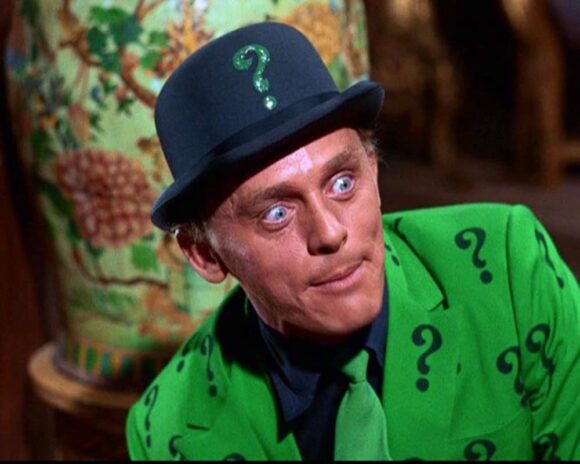
—
“The Joker is Wild/Batman Is Riled” (Jan. 26-27, 1966). The episode that introduced the immortally mustachioed Cesar Romero as the Joker. Please bear in mind that most of the members of the Caped Crusader’s Rogue’s Gallery had been in editorial hibernation in the comic books for several years by the time Batman ’66 hit the airwaves, so barring random stories reprinted in Batman Annuals, even comic book readers of my age were unlikely to have ever seen these characters before.
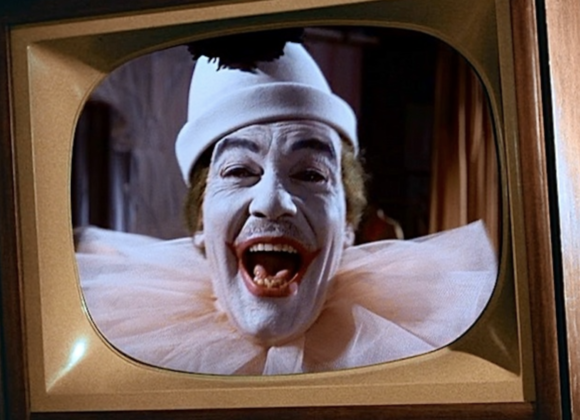
—
“The Purr-fect Crime/Better Luck Next Time” (March 16-17, 1966). Julie Newmar as Catwoman, OK?
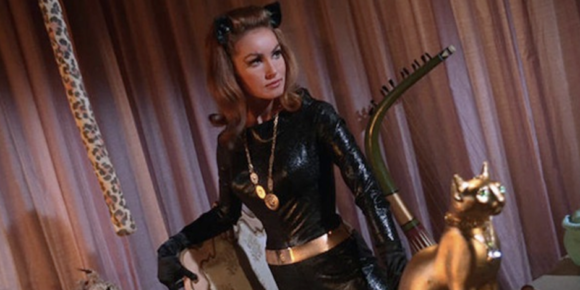
—
“The Penguin Goes Straight/Not Yet He Ain’t” (March 23-24, 1966). It took me a while to warm up to Penguin. I found the character and his tricked out umbrellas ridiculous and annoying. I mean, how could Batman not just stomp this ridiculous bird into paste? But Burgess Meredith’s charmingly absurdist performance eventually won me over. >Waah! Waah!<
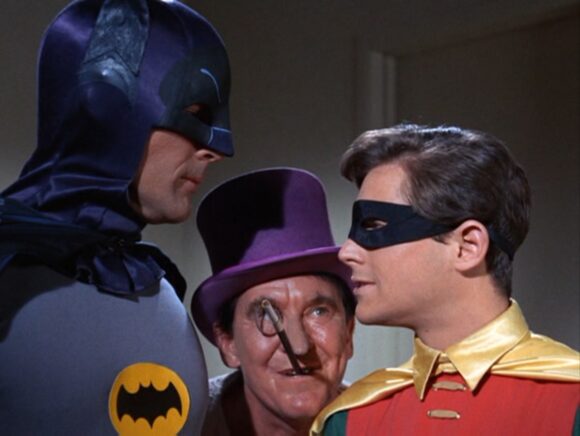
—
“The Bookworm Turns/While Gotham City Burns” (April 20-21, 1966). No doubt Roddy McDowall’s character of Bookworm was pushing it even for silly Batman ’66 villains, but this episode featured the first “guest-star window pop-in,” which happened to be the one and only Jerry Lewis, my comedy hero. (I wrote about this episode at length in Zlonk! Zok! Zowie! The Subterranean Blue Grotto Essays on Batman ’66 – Season One.)
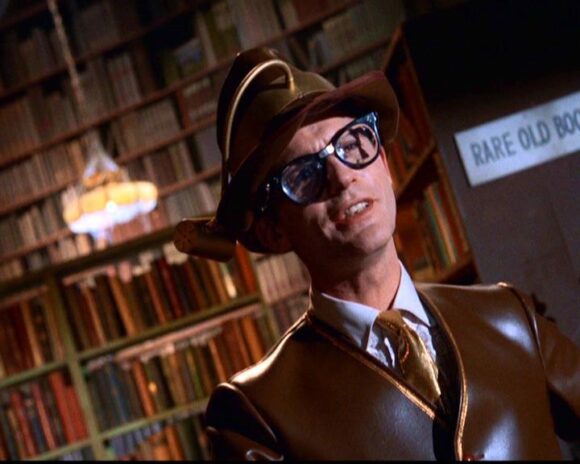
—
“Shoot a Crooked Arrow/Walk the Straight and Narrow” (Sept. 7-8, 1966). The inimitable Art Carney guest-villains, bringing his pitch-perfect comic timing to the medieval silliness of the Archer.
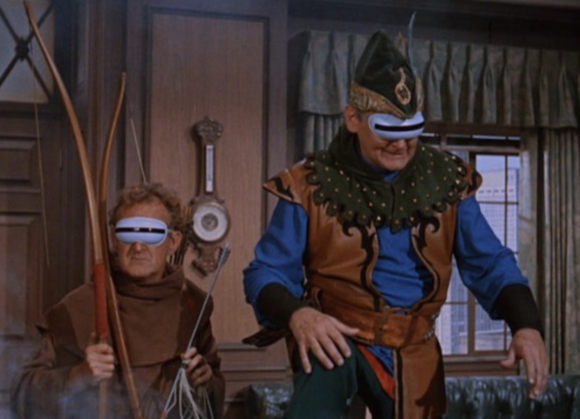
—
“Hot Off the Griddle/The Cat and the Fiddle” (Sept. 14-15, 1966). Catwoman returned (she made 13 appearances in all, number three in the rankings after the Joker’s 22 episodes and the Penguin’s 23), this time with an overly complicated plan to steal something so she can then steal something else. Bonus, a young James Brolin as armored car driver Ralph Staphylococcus. More on this episode by me in Biff! Bam! Eee-Yow! The Subterranean Blue Grotto Essays on Batman ’66 – Season Two.
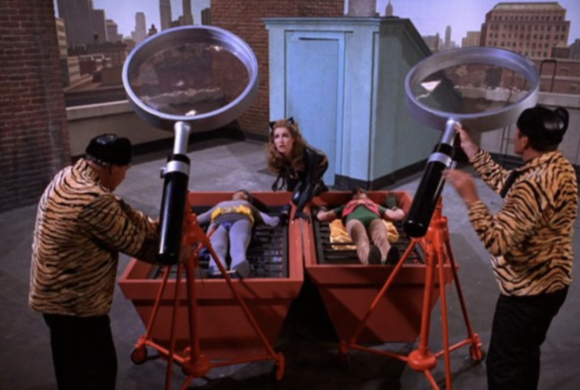
—
“The Spell of Tut/Tut’s Case Is Shut” (Sept. 28-29, 1966). You don’t actually have to like the taste of scenery yourself to love just how much Victor Buono chewed it as King Tut.
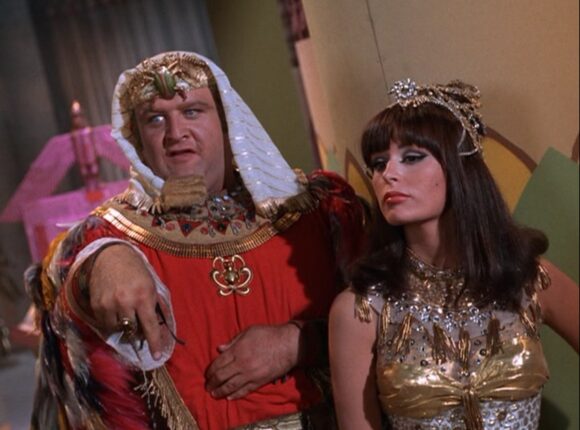
—
“The Zodiac Crimes/The Joker’s Hard Times/The Penguin Declines” (Jan. 11, 12 and 18, 1967). A second-season spectacular, this three-part episode teams the Joker and the Penguin for a massive crime spree designed to drive Batman and Robin crazy.
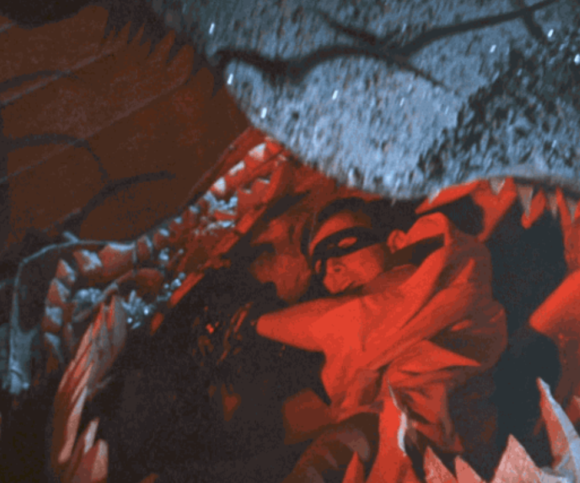
—
“Black Widow Strikes Again/Caught in the Spider’s Den” (March 15-16, 1967). Silent screen siren Tallulah Bankhead as the mesmerizing Black Widow. I was 11 and she scared the hell out of me.
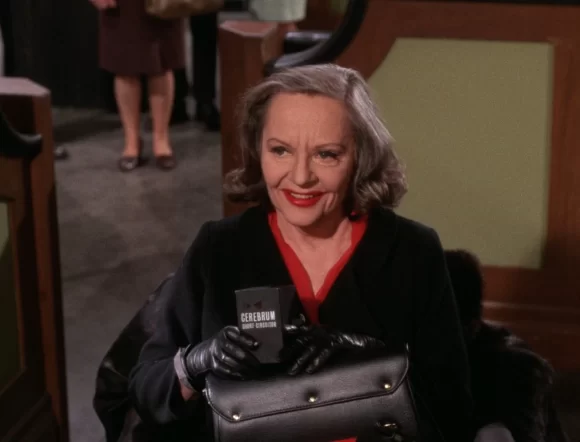
—
“Louie, the Lilac” (Oct. 26, 1967). Batman ’66 was a mid-decade phenomenon that had stars from stage and screen clamoring to play guest villains. The producers largely went with old school stars, the actors of “Old Hollywood,” some of whose careers dated back to silent movies, including Ms. Bankhead, above, and comedian Milton Berle as the bane of 1960s TV hippies, Louis the Lilac. (More on Louie in my essay for the upcoming Oooff! Boff! Splatt! The Subterranean Blue Grotto Essays on Batman ’66 – Season Three.)

—
“Catwoman’s Dressed to Kill” (Dec. 14, 1967). Because the fabulous Eartha Kitt as the replacement Catwoman for Julie Newmar (who was otherwise engaged making a movie), deserves mention of her own for bringing new dimensions of sensuality to the character.
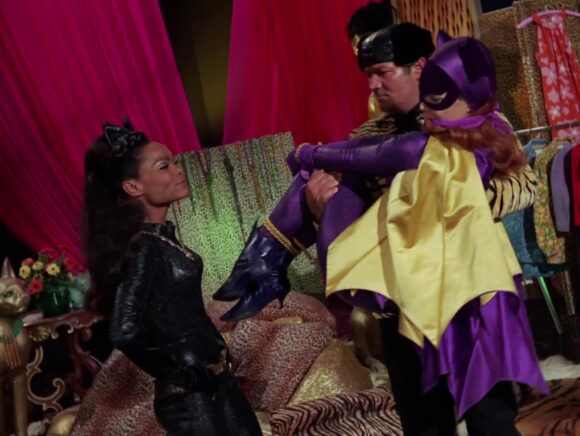
—
“Minerva, Mayhem, and Millionaires” (March 14, 1968). Batman ’66 had hobbled its way to the end of its third and final season, the camp show of the decade guest-starring a 1960s Queen of Camp, Miss Hungary of 1936, Zsa Zsa Gabor. It was mahvelous, dahlink. Just like Batman ’66.
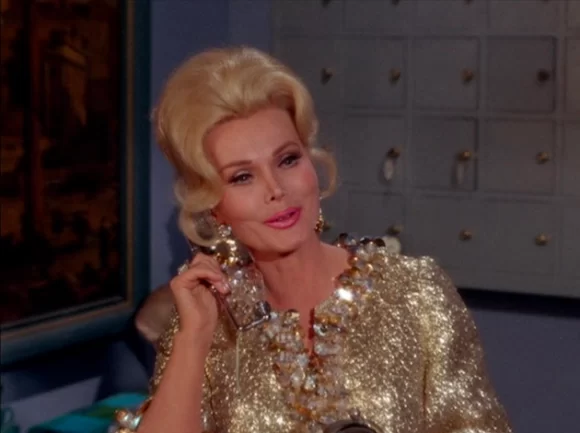
—
MORE
— 13 THINGS to Love About BATMAN ’66, by JIM BEARD. Click here.
— ALAN NAPIER’s ALFRED: His 13 Greatest BATMAN ’66 Adventures. Click here.
— RETRO HOT PICKS! On Sale This Week — in 1966! Click here.
—
Sure, you know Paul Kupperberg as the prolific writer of over a thousand comic books for such characters and series as Superman, Aquaman, Doom Patrol, Vigilante, Life with Archie, Bart Simpson, Scooby-Doo, and dozens more for DC Comics, Archie Comics, Bongo Comics, and others, and that he is also the creator of the series Arion, Lord of Atlantis, Checkmate and Takion, and is a former editor for DC, Weekly World News, and WWE Kids Magazine. But Paul is also the author of numerous books, including the superhero novel JSA: Ragnarok and the comics industry-based murder mystery, The Same Old Story, not to mention (but we will anyway) Paul Kupperberg’s Illustrated Guide to Writing Comics, I Never Write for the Money, But I Always Turn in the Manuscript for a Check, Direct Comments: Comic Book Creators in their Own Words, The Unpublished Comic Book Scripts of Paul Kupperberg and Son of the Unpublished Comic Book Scripts of Paul Kupperberg. You can follow Paul at PaulKupperberg.com and at Crazy8Press.com.
